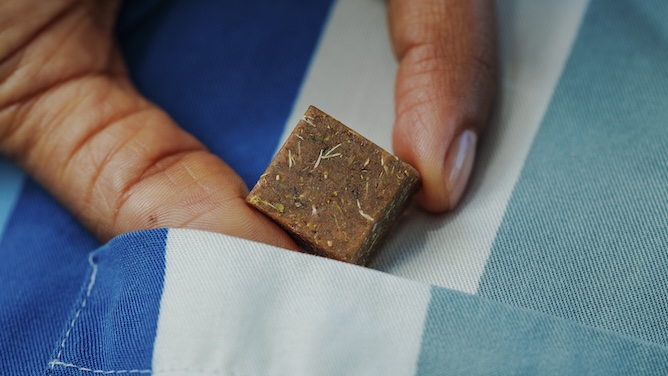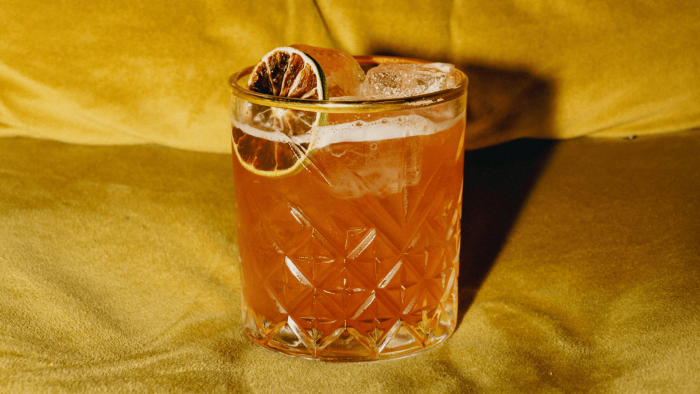In early January, a package of KA! chews and tincture landed on my doorstep. These empathogenic supplements claim to reduce stress and increase joy (or at least a more general feeling of being content). I’m not typically someone who adheres to a “new year, new you” mindset. I am, however, all for trying natural, research-backed products at least once to see if they live up to their claims.
There’s an argument to be made that we’re living in the golden age of functional foods, drinks, and supplements specially designed to make one feel better. There’s an embarrassment of riches in the broader “wellness” category. Some are dubious amalgamations of compounds that are designed to generally make you happy. Others, like KA!, are based around traditional plants.
At the heart of KA! is the South African succulent kanna. The benefits come from the natural alkaloids in the plant, including mesembrine, mesembrenone, mesembrenol, tortuosamine, and chennaine. These have various effects on the nervous system.
Kanna has been used for thousands of years both medicinally and recreationally by Khoi and San indigenous peoples as a mood and endurance booster that reduces stress, tension, depression, and anxiety. Human and animal studies have also found that, compared to a placebo, kanna positively impacts mood, sleep, attention, and memory. Still, it’s been largely left out of the wider wellness conversation in Western cultures. This is despite records by Western explorers and colonizers as far back as the 1600s describing kanna as having an “agreeable, hearty taste” and being the “greatest cheerer of spirits, and the noblest restorative in the world.”
KA! blends other plant ingredients into its chews designed to work alongside kanna, while the tincture has a salivary stimulant and uses glycerin extraction instead of alcohol extraction for a final product that reduces nausea. Both create an immediate numbing tingly feeling that’s not too different from Szechuan peppercorns.
I used them for a month in place of coffee before starting my workday and as an afternoon pick-me-up to keep my focus through work hours that are generally more of a drag. Noticing the awake-but-not-jittery feeling, I also turned to KA! on a few weekends when the idea of heading out to meet friends for a drink felt like a tall task after an exhausting week. I felt more alert for hours after each dose – similar to the feeling of content stillness I get just after a proper meditation session.
To learn more about kanna and what sets KA! apart from other wellness products out there, I caught up with KA! founder and CEO Stephanie Wang.
This interview has been edited for length and clarity.
Cool Material: Can you tell me about how you first encountered kanna and why you were inspired to start KA!?
Stephanie Wang: I discovered Kanna during my first-ever plant ceremony in 2013. While on a ceremonial dose of this life-changing empathogen, I felt my heart expand more than I ever imagined possible, accompanied by a deep sense of acceptance and belonging. For the first time in my life, I felt all the stresses of the world melt away. At a time when I know people need it the most, I felt my mission emerge to help make this plant medicine accessible to as many as humanly possible. We are ushering in the next revolution in mental health, powered by plants.
What was the inspiration behind adapting kanna into forms like gummies and tinctures? Were other delivery methods tested or explored?
First off, our Kanna Chews are not gummies, they’re chews. This is a very important distinction because gummies are usually made with sugar and heated up to anywhere between 120 to 250 degrees Fahrenheit. Our patent-pending chews are made with an innovative process that does not use sugar or heat so the ingredients don’t get degraded and remain highly bioactive. We wanted to create as clean and healthy a product as possible.
"What you’re eating is alive, to make you feel more alive."
The KA! Kanna Chews were inspired by how the indigenous Khoikhoi and San of southern Africa would traditionally ingest kanna, which was to chew the leaves, stems and roots, usually after they ferment it. It was a nod to their stewardship of the plant and their wisdom of how to work with this amazing succulent. In fact, kanna is also known as kougoed – the Afrikaans name that means “something to chew.”
We developed the tincture because it is a delivery method that’s very familiar for people who take herbal supplements. Since tinctures are taken sublingually, the effect is more immediate because the kanna alkaloids are absorbed more directly through the mucosal membrane in the mouth vs. through the gastrointestinal tract. It’s great for people who are looking for that instant peak effect instead of the more time-released effect the chew provides. It’s also ideal for microdosing since you can more precisely measure out milligram by milligram. That’s hard to do with the chew. Together, the KA! chew and tincture make a great combo – take the chew in the morning to set the tone for all-day grounded energy, focus and calm. Then re-up with the tincture when you are feeling like you need a quick energy boost later in the afternoon and into the evening. We also liked the tincture delivery method because of its liquid form which can easily be incorporated into the social scene. There is a growing sobriety movement where people are looking to feel good without alcohol. Adding the KA! kanna tincture to a mocktail is a great way to make an alcohol-free libation an actual stress-busting, mood-lifting state-changer, without the mental impairment or hangover of alcohol. Kanna promotes intimacy and sociability and can help to lower social anxiety.
Other delivery methods were tested and explored but in the end we felt strongly to launch the chews and tincture first.
Mood boosters seem to be having a moment right now. What sets kanna apart, and why do you think other pick-me-ups have been trending up?
The pandemic exacerbated feelings of loneliness and isolation, and we are still feeling the consequences of that. People are experiencing more stress than ever before, especially now given the current geopolitical landscape and economic pressures they are facing. People want to feel better about themselves and about their lives. Right now, the psychedelic renaissance is in full swing making psychoactive and psychedelic plants and substances more mainstream. This makes it more acceptable to try psychoactive plants for mood-boosting, anxiety-relief, and trauma-healing.
What sets kanna apart from many other mood-boosting psychoactives is that it’s legal (in all states except Louisiana) in the U.S. and internationally as far as I know. To be clear, kanna is psychoactive but not psychedelic, meaning it will not get you “high” and make you hallucinate. It’s neuroprotective and adaptogenic, which means it is not toxic to your system, and you can take it consistently over a long period of time. Doing so regulates your nervous system to make it more resilient so you’re less easily triggered into fight or flight. In comparison for example, you cannot take MDMA for long periods as it can cause damage to your neuroreceptors. Although kanna’s empathogenic, heart-opening qualities are less intense than MDMA, there is no risk for addiction. Kanna has also been shown to improve cognition, focus and physical endurance which adds to its list of unique qualities. There is also no crash after effects wear off. One of the reasons for this is because Kanna targets multiple neuroreceptors for multiple functions at once, vs. other substances that target a single type of receptor to displace and block chemicals.
Can you tell me about the sourcing that KA! Uses?
We source directly from South Africa the best quality Kanna extract derived from specific species of Sceletium tortuosum with optimal alkaloid balance that is extracted using a patented process, producing a standardized extract of uniquely high potency. The Kanna we use is cultivated in farms and does not endanger Kanna in the wild. All of our ingredients are sourced and grown without the use of pesticides, herbicides or chemical agents, and our packaging is eco-friendly. We source our Kanna from a provider that shares profit with the KhoiKhoi, one of the traditional stewards of Kanna, giving 3 percent of revenue to the Kai !Korana Community. We are also actively seeking a partnership of our own with an aligned non-profit.

Credit: KA!
One of the biggest questions I get from readers when writing about wellness products is how do they know it’s something that people can trust from a production safety and product consistency standpoint. What ways do you ensure there’s the right amount of transparency with KA!?
Look for documentation on third-party testing of products to ensure safety. These test for microbial safety and for heavy metals. Also ask for certificates of analysis (COA) for the ingredients to verify the level of active ingredients. For larger companies check to see if they have clinical studies that back their product claims. We ensure the right amount of transparency with KA! by having our products third-party tested and by having COAs for the kanna we use. In future, we plan to do clinical studies as well when we are able to.
What went into blending the formula used for KA!, and how were those particular plants narrowed down?
A lot of love! Besides that, expertise in biochemistry, molecular biology, herbalism and flavor science all went into the creation of KA! offerings. The ingredients were carefully chosen and intentionally formulated based on several criteria: by paying attention to the ancient wisdom and traditional knowledge systems and practices around the plants, by meticulous scientific research of each ingredient and their mechanism of action with the other ingredients combined, and by carefully looking at each phytochemical energy metabolism, and the combined olfactory and medicinal effects the final product exerts on the biochemistry of the end-user. It’s a combination of ancient wisdom and modern science. We went through many iterations to find the perfect balance of synergistic ingredients to help people feel more alive, calm, uplifted with grounded energy, focused, and with greater empathy and sense of wellbeing.
More Lifestyle

London Doesn’t Have to Be Lavish to Travel Well
Your smart, stylish, and affordable guide to visiting the UK capital.

How to Give the Gift of Pappy This Year (Even If You Can’t Get Your Hands on a Bottle)
You don’t need a rare hookup to gift a piece of bourbon history.

6 N/As Every Guy Should Have on Hand During the Holidays
Happy HoliN/As!

